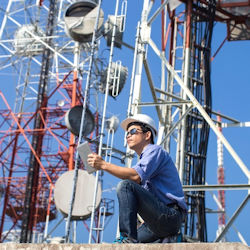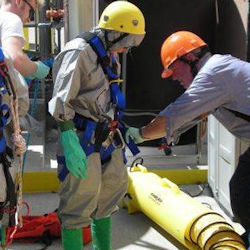06.G.02 Radio Frequency and Electromagnetic Radiation.
- Ensure that no employee is exposed to electric or magnetic fields, radio frequency (RF) including infrared, ultraviolet, and microwave radiation levels exceeding the values listed in the ACGIH Threshold Limit Values and Biological Exposure Indices.
- Routine use of RF protective clothing to protect personnel is prohibited.
- (1) Protective equipment, such as electrically insulated gloves and shoes for protection against RF shock and burn, or for insulation from the ground plane, is permissible when engineering controls or procedures cannot eliminate exposure hazards.
- (2) Users will identify, attenuate, or control potentially hazardous RF electromagnetic fields and other radiation hazards associated with electronic equipment by engineering design, administrative actions, or protective equipment, (in that order), or a combination thereof. Use process and engineering controls before PPE to protect employees.
- All personnel routinely working with RF emitting equipment where exposures may exceed TLVs will receive training in RF hazards, procedures for minimizing these hazards, and their responsibility to limit potential overexposures. Operator's manuals, Training Orders, Equipment SOPs, etc. will be available for all RF generating equipment and safety guidance will be followed.
- Whenever personnel are potentially exposed to RF fields exceeding PELs, the fields will be measured and evaluated using Institute of Electrical and Electronics Engineers (IEEE) guidance. District and/or project safety personnel will use this information and document RF environments. Where multiple RF electromagnetic radiation emitters are located in fixed arrangements, RF evaluation data will include a determination of weighted contributions from expected simultaneously operated emitters.
0.6.H Ventilation and Exhaust Systems.
06.H.01 Portable and Temporary Ventilation Systems.
- All portable or temporary ventilation systems must remove dusts, fumes, mists, vapors and gases away from the worker and the work environment or provide air to prevent an oxygen deficient atmosphere.
- Portable or temporary ventilation systems must be used as designed by the manufacturer. All hoses must be only as long as the maximum allowed by the manufacturer to provide the required air flow at the supply or exhaust point. If adding or changing hoses, only hoses and/or connectors must be used that are comparable and compatible with the hoses and connectors provided by the manufacturer.
- Make-up air for air supply ventilation systems must draw air free of contaminants and away from any potential contaminant source.
- Any portable or temporary ventilation system and the locations where the systems are to be used must be approved by the GDA or SOHO before use. Manufacturer information or design criteria must be provided with the request for approval.
- Airborne contaminants created by portable or temporary ventilation systems (such as drills, saws, and grinding machines) in concentrations exceeding acceptable safe limits must be effectively controlled at the source. See Section 06.A.03.
- The use of high efficiency, filtered, recirculated ventilation units must be allowed when:
- (1) The filtration system lowers the levels of any of the toxic fumes or dust from the operation to less than half of the OEL. This must be documented by an IH or CP through sampling for the contaminants.
- Note: Welding, carbon monoxide, ozone, and carbon dioxide are common contaminants that are not filtered out by most filtration devices.
- (2) The unit and filtration are regularly maintained and the maintenance procedure and schedule is written and documented when maintenance is completed.
- (3) The air is not recirculated into a confined space.
- (4) The contaminant is not beryllium or chromium. Fumes or particulate from beryllium or chromium are not to be filtered and recirculated.
06.H.02
Ventilation systems must be operated and maintained in such a manner to ensure the maintenance of a volume and velocity of exhaust air sufficient to gather contaminants and safely transport them to suitable points for removal.
Knowledge Check Choose the best answer for the question.
6-14. Airborne contaminants created by portable or temporary ventilation systems in concentrations exceeding acceptable safe limits must be _____.
You forgot to answer the question!


